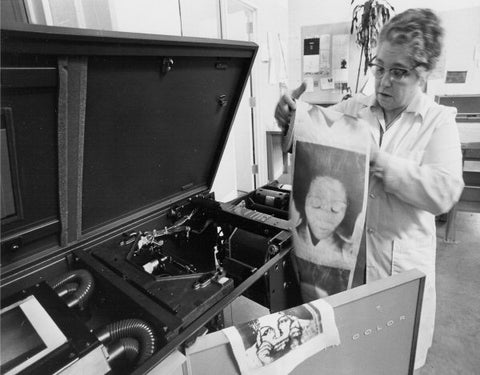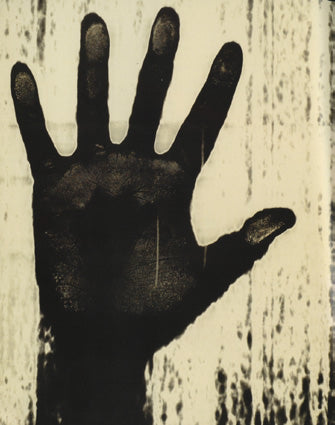Please allow 7 working days to process before shipping
! Pants run small, we recommend going a full size up !
White painter pants — 30" inseam
8.75oz painter's drill fabric, 100% cotton
triple-stitched seams, 9 pockets
April Greiman

“I believe that all designers come to a task with a unique way of ordering that is particular to their past experiences, and perhaps even their genetic structure. As a student I became aware of these tendencies; began to trust and develop them. Ideas, hunches and personal visualizations result for that integration of mind and body. Intuition is a kind of non-thinking that cuts through socialization, and is therefore our highest form of intelligence.”

April Greiman was born in New York in 1948. She attended the Allgemeine Kunstgewerbeschule in Basel, Switzerland under Armin Hofmann and Wolfgang Weingart, and the Kansas City Art Institute before working as a graphic designer in New York and teaching at the same time at the Philadelphia College of Art. In 1976 April Greiman moved to California, where she opened a graphic design studio in Los Angeles: "Made in Space, Inc.".


April Greiman's graphic style links American Postmodernism with the rational clarity of the Swiss school. Her graphic works, often collage-like, consist of layers of lettering and pictures, whose elements seem to float. April Greiman's work shaped the Californian New Wave style.
In the 1980s, April Greiman soon became aware of the possibilities the new digital technology in the form of Apple MacIntosh and Quantel Paintbox would offer design and was one of the first to take advantage of them. April Greiman is regarded as one of the most influential women graphic artists working in the digital media. In 1982 April Greiman became head of the design department at the California Institute of the Arts. April Greiman's book "Hybrid Imagery: The Fusion of Technology and Graphic Design" was published in 1990.

As an early adopter of the MacIntosh computer, Greiman produced an issue of Design Quarterly in 1986, notable in its development of graphic design. Entitled “Does it make sense?”, the edition was edited by Mildred Friedman and published by the Walker Art Center. "She re-imagined the magazine as a poster that folded out to almost three-by-six feet. It contained a life-size, MacVision-generated image of her outstretched naked body adorned with symbolic images and text— a provocative gesture, which emphatically countered the objective, rational and masculine tendencies of modernist design."


Greiman’s style matured in the 1990s, when her work began to reflect the aesthetic range and possibility of the internet. “Things are becoming more holistic in my work so maybe that gives the feeling of being purer or simpler,” she explained in a 1994 interview with Creative Review’s Howard Rombough. “A lot of simple things can be profound…I’m reductivist with individual things, but then I end up putting a plurality of messages, objects, subjects into a piece.”

Sonia Landy Sheridan

Sonia Landy Sheridan is an American artist and academic best known for her work with xerography and electronic imaging. She moved to New York City in 1929 where she studied French and visual arts at Hunter College earning her Bachelor degree, then went on to do her graduate studies at Columbia University. In 1951 she moved to San Francisco Bay Area where she lived for 10 years before making her way to Chicago.


In the early 1960s, she became interested in the use of communication technology in art and began to establish professional contacts with industry. From 1969 until the mid-1970s, Sheridan was artist in residence at 3M and experimented with various imaging systems, such as color reprography. At her request, the Art Institute of Chicago initially rented and eventually acquired a 3M Color-in-Color (thermal process color photocopier), to which were later added other photocopiers, computers and digital image processing tools.


In 1970, Sheridan initiated a program entitled Generative Systems, which introduced students to various reprography techniques and, in due course, to the basics of infography and computer animation. As students became technically competent, they also learned about the advanced research being conducted by engineers in the reproduction technology sector (xerography, electronic imaging). In 1980, Sheridan left her position as professor and was awarded Professor Emerita status in June 1982.

In the meantime, she continued with her artwork, and in 1974 she exhibited at the MoMA of New York together with Keith Smith. Her artistic works were shown in many different institutions, the most relevant in 1969 at the exhibition the "Software Show" at the Jewish Museum in New York, where they did a historic catalogue. For the first time in Europe, within the collective exhibition Electra, made in the year 1983, at the Musée d'Art Moderne de la Ville de Paris. In this exhibition she presented the first image manipulation software for artists, Lumena artware of TimeArts.

Three years later, her work was shown for the first time in Spain, together with other artists such as Nam June Paik, Marisa Gonzalez, Paloma Navares, Marina Abramovic, John Cage... at the inaugural collective exhibitions of the Museo Nacional Centro de Arte Reina Sofía of Madrid titled "Procesos: Cultura y nuevas tecnologías", which offered a compilation of different artistic approximations by the use of the new means that arose in the contemporary art during the second half of the 20th century, and in which she presented, apart of her work, the graphic computer invented by her student of SAIC, John Dunn, the EASEL software and Time Arts PC computer. With this system, during a month, she made a workshop open to all the public at the exhibitions rooms of the Museo Reina Sofía.












